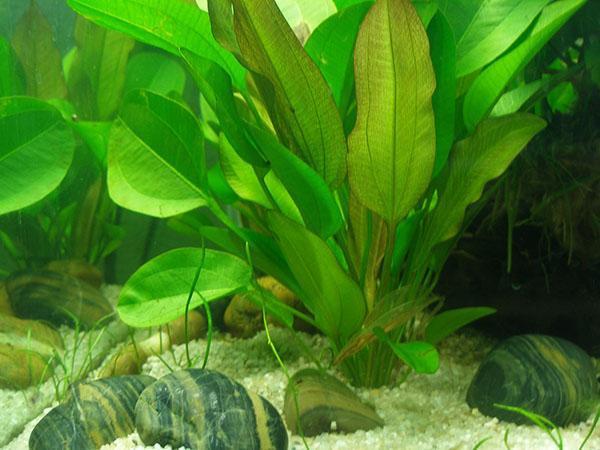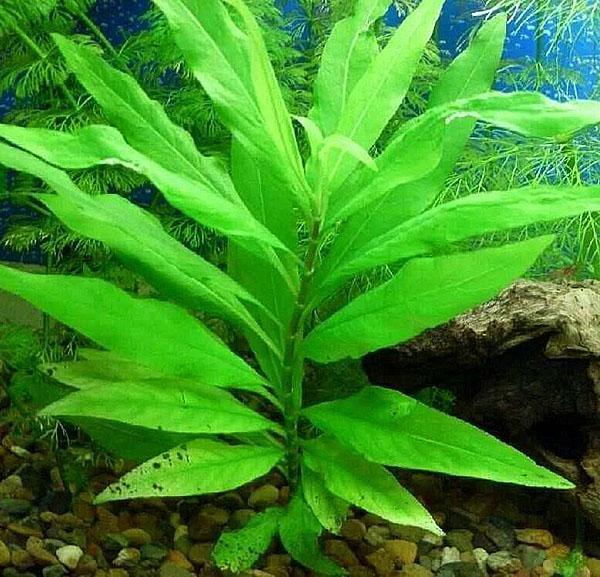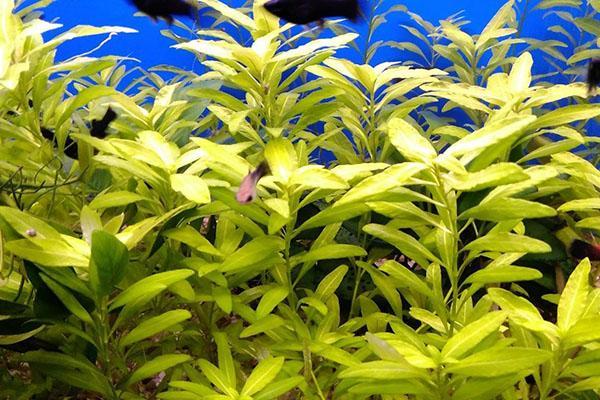Lemongrass aquarium plant: features of cultivation and care
 On the shores of small swampy reservoirs of Southeast Asia, you can find dense thickets of an amazing plant. Aquarium plant lemongrass, large Indian bog, straight nomaphila (Nomaphila stricta) - under these names the freshwater inhabitant of the tropics of the acanthus family is known.
On the shores of small swampy reservoirs of Southeast Asia, you can find dense thickets of an amazing plant. Aquarium plant lemongrass, large Indian bog, straight nomaphila (Nomaphila stricta) - under these names the freshwater inhabitant of the tropics of the acanthus family is known.
The ability to develop equally well in the air and under water, its beautiful appearance made the plant popular with fans of aquarium flora.
External signs of lemongrass aquarium

- The plant has the shape of a dense bush 30–40 cm high.
- The stem is straight, powerful, with a well-developed root system.
- Leaves are oval in shape with a wedge-shaped base and a pointed end. The surface side is light green, the back is greenish-silver. The location on the stem is opposite.
The aquarium plant lemongrass, under favorable conditions, often reaches a height of 50-60 cm. Its upper part rises above the water surface, the leaves become rough, and medium-sized blue flowers with a lilac shade may appear at their base.
A complete picture of the appearance is given by a photo of the aquarium plant lemongrass.
Features of the content
 Nomafila straight adapts well enough in an artificially created environment. Subject to the simple rules of care, it will actively grow and multiply for a long time.
Nomafila straight adapts well enough in an artificially created environment. Subject to the simple rules of care, it will actively grow and multiply for a long time.
Lemongrass in an aquarium feels better in a group. 2–3 plants planted near the back wall will create a lush green background. The optimum volume of the aquarium should be at least 150 ml.
It should be remembered that lemongrass is an inhabitant of tropical waters. The natural habitat determines the norms for keeping lemongrass of an aquarium plant according to a number of priority indicators:
- Water of medium hardness, with a neutral or slightly alkaline pH value (pH 7–8.5). It is necessary to replace 30% of water once every 7-10 days. The most comfortable temperature is within 24-28ºC;
- Intense lighting using direct sunlight or electroluminescent lamps. The power of an artificial source is determined at the rate of 0.5 W per liter of water. With sufficient light, the stem of lemongrass is brown;
- Soil 5 to 7 cm thick, silted, with a rich nutrient medium in the form of phosphorus, magnesium, calcium (you can purchase special complex fertilizers). River sand can be used as soil, but then clay should be placed under the plant to provide the necessary support for the root system
Under favorable conditions for keeping lemongrass in the aquarium, the plant stretches 10 cm per week. It often fills the space, suppressing other flora. You can avoid the problem. For this, lemongrass is planted not in the ground, but in a clay pot.
Choose a small container. Otherwise, lemongrass will direct forces to build up the root system to the detriment of the green mass.
Reproduction and cutting of lemongrass
 The plant is propagated by cuttings.The apical shoot is cut about 5 cm and planted in prepared soil or a low container of water. The procedure allows you to develop in width and give new shoots.
The plant is propagated by cuttings.The apical shoot is cut about 5 cm and planted in prepared soil or a low container of water. The procedure allows you to develop in width and give new shoots.
It is necessary to trim the lemongrass aquarium plant not only for reproduction. An adult nomaphila rising above the water sometimes sheds all the lower leaves. Removing the tip will help avoid the problem.
Twice a year, lemongrass is rejuvenated by removing old, weak and unpresentable shoots. If this is not done, it will not bloom.
The high decorative qualities of lemongrass make it a desirable inhabitant not only of aquariums, but also of the increasingly popular aquatic gardens - paludariums. The plant feels great in greenhouses. The requirements for soil composition and lighting are the same as for water content. In the air, lemongrass quickly gives rise to strong shoots that can be rooted in aquarium soil.
Lemongrass aquarium plant: diseases, treatment methods
 Changes in the conditions and norms of keeping nomafila can cause various diseases.
Changes in the conditions and norms of keeping nomafila can cause various diseases.
Eliminating unfavorable factors will return the lemongrass to the aquarium plant a healthy look.
The development of lemongrass aquarium occurs continuously, for it there is no autumn-winter period of slowing down of life processes. Subject to the specified parameters of water and light, the presence of a sufficient amount of nutrient soil, the plant will delight all year round with lush foliage, a pleasant lemon aroma and delicate flowers.